Imagine a bird, such as a graceful eagle, soaring through the sky. The way a bird flies can help us understand aerodynamics:
- Wings as Airfoils:
- Think of the bird’s wings as special shapes called airfoils. These airfoils are designed to create lift, which is the force that keeps the bird in the air.
- Flapping and Gliding – Bird’s Flight Techniques:
- Birds use a combination of flapping and gliding. Flapping generates lift and thrust, while gliding allows the bird to cover more distance without expending too much energy.
- Tail Feathers as Control Surfaces:
- Notice how a bird’s tail feathers play a role in steering and controlling the direction of flight. These tail feathers act like the control surfaces on an airplane.
- Facing the Wind – Bird’s Aerodynamic Pose:
- Birds often face into the wind when flying. This minimizes air resistance (drag) and allows for more efficient flight. It’s like a bird’s aerodynamic pose.
- Soaring on Updrafts – Efficient Use of Air Currents:
- Birds take advantage of air currents and updrafts. Soaring in these currents allows them to cover great distances with minimal effort, much like a pilot using air currents in gliding.
- Landing Techniques – Controlled Descent:
- When it’s time to land, a bird adjusts its wings and tail feathers to slow down and make a controlled descent. This is similar to how an airplane descends for landing.
Real-Life Connection:
- Airplane Wings and Bird Wings: The shape and function of airplane wings are inspired by bird wings. Both are designed to generate lift and allow for controlled flight.
- Streamlined Body: A bird’s streamlined body reduces drag, helping it cut through the air more efficiently. This concept is applied in designing fast-moving vehicles like cars.
By associating aerodynamics with the familiar image of a bird in flight, kids can grasp the basic principles of lift, drag, and control surfaces in a way that’s relatable and engaging.


No responses yet